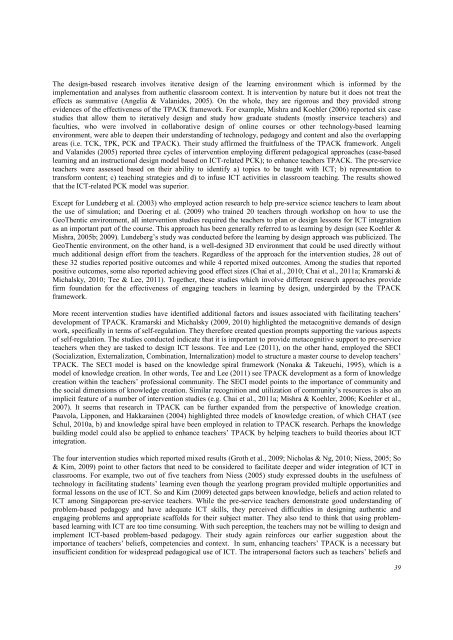Download Complete Issue in PDF - Educational Technology & Society
Download Complete Issue in PDF - Educational Technology & Society
Download Complete Issue in PDF - Educational Technology & Society
Create successful ePaper yourself
Turn your PDF publications into a flip-book with our unique Google optimized e-Paper software.
The design-based research <strong>in</strong>volves iterative design of the learn<strong>in</strong>g environment which is <strong>in</strong>formed by the<br />
implementation and analyses from authentic classroom context. It is <strong>in</strong>tervention by nature but it does not treat the<br />
effects as summative (Angelia & Valanides, 2005). On the whole, they are rigorous and they provided strong<br />
evidences of the effectiveness of the TPACK framework. For example, Mishra and Koehler (2006) reported six case<br />
studies that allow them to iteratively design and study how graduate students (mostly <strong>in</strong>service teachers) and<br />
faculties, who were <strong>in</strong>volved <strong>in</strong> collaborative design of onl<strong>in</strong>e courses or other technology-based learn<strong>in</strong>g<br />
environment, were able to deepen their understand<strong>in</strong>g of technology, pedagogy and content and also the overlapp<strong>in</strong>g<br />
areas (i.e. TCK, TPK, PCK and TPACK). Their study affirmed the fruitfulness of the TPACK framework. Angeli<br />
and Valanides (2005) reported three cycles of <strong>in</strong>tervention employ<strong>in</strong>g different pedagogical approaches (case-based<br />
learn<strong>in</strong>g and an <strong>in</strong>structional design model based on ICT-related PCK); to enhance teachers TPACK. The pre-service<br />
teachers were assessed based on their ability to identify a) topics to be taught with ICT; b) representation to<br />
transform content; c) teach<strong>in</strong>g strategies and d) to <strong>in</strong>fuse ICT activities <strong>in</strong> classroom teach<strong>in</strong>g. The results showed<br />
that the ICT-related PCK model was superior.<br />
Except for Lundeberg et al. (2003) who employed action research to help pre-service science teachers to learn about<br />
the use of simulation; and Doer<strong>in</strong>g et al. (2009) who tra<strong>in</strong>ed 20 teachers through workshop on how to use the<br />
GeoThentic environment, all <strong>in</strong>tervention studies required the teachers to plan or design lessons for ICT <strong>in</strong>tegration<br />
as an important part of the course. This approach has been generally referred to as learn<strong>in</strong>g by design (see Koehler &<br />
Mishra, 2005b; 2009). Lundeberg’s study was conducted before the learn<strong>in</strong>g by design approach was publicized. The<br />
GeoThentic environment, on the other hand, is a well-designed 3D environment that could be used directly without<br />
much additional design effort from the teachers. Regardless of the approach for the <strong>in</strong>tervention studies, 28 out of<br />
these 32 studies reported positive outcomes and while 4 reported mixed outcomes. Among the studies that reported<br />
positive outcomes, some also reported achiev<strong>in</strong>g good effect sizes (Chai et al., 2010; Chai et al., 2011a; Kramarski &<br />
Michalsky, 2010; Tee & Lee, 2011). Together, these studies which <strong>in</strong>volve different research approaches provide<br />
firm foundation for the effectiveness of engag<strong>in</strong>g teachers <strong>in</strong> learn<strong>in</strong>g by design, undergirded by the TPACK<br />
framework.<br />
More recent <strong>in</strong>tervention studies have identified additional factors and issues associated with facilitat<strong>in</strong>g teachers’<br />
development of TPACK. Kramarski and Michalsky (2009, 2010) highlighted the metacognitive demands of design<br />
work, specifically <strong>in</strong> terms of self-regulation. They therefore created question prompts support<strong>in</strong>g the various aspects<br />
of self-regulation. The studies conducted <strong>in</strong>dicate that it is important to provide metacognitive support to pre-service<br />
teachers when they are tasked to design ICT lessons. Tee and Lee (2011), on the other hand, employed the SECI<br />
(Socialization, Externalization, Comb<strong>in</strong>ation, Internalization) model to structure a master course to develop teachers’<br />
TPACK. The SECI model is based on the knowledge spiral framework (Nonaka & Takeuchi, 1995), which is a<br />
model of knowledge creation. In other words, Tee and Lee (2011) see TPACK development as a form of knowledge<br />
creation with<strong>in</strong> the teachers’ professional community. The SECI model po<strong>in</strong>ts to the importance of community and<br />
the social dimensions of knowledge creation. Similar recognition and utilization of community’s resources is also an<br />
implicit feature of a number of <strong>in</strong>tervention studies (e.g. Chai et al., 2011a; Mishra & Koehler, 2006; Koehler et al.,<br />
2007). It seems that research <strong>in</strong> TPACK can be further expanded from the perspective of knowledge creation.<br />
Paavola, Lipponen, and Hakkara<strong>in</strong>en (2004) highlighted three models of knowledge creation, of which CHAT (see<br />
Schul, 2010a, b) and knowledge spiral have been employed <strong>in</strong> relation to TPACK research. Perhaps the knowledge<br />
build<strong>in</strong>g model could also be applied to enhance teachers’ TPACK by help<strong>in</strong>g teachers to build theories about ICT<br />
<strong>in</strong>tegration.<br />
The four <strong>in</strong>tervention studies which reported mixed results (Groth et al., 2009; Nicholas & Ng, 2010; Niess, 2005; So<br />
& Kim, 2009) po<strong>in</strong>t to other factors that need to be considered to facilitate deeper and wider <strong>in</strong>tegration of ICT <strong>in</strong><br />
classrooms. For example, two out of five teachers from Niess (2005) study expressed doubts <strong>in</strong> the usefulness of<br />
technology <strong>in</strong> facilitat<strong>in</strong>g students’ learn<strong>in</strong>g even though the yearlong program provided multiple opportunities and<br />
formal lessons on the use of ICT. So and Kim (2009) detected gaps between knowledge, beliefs and action related to<br />
ICT among S<strong>in</strong>gaporean pre-service teachers. While the pre-service teachers demonstrate good understand<strong>in</strong>g of<br />
problem-based pedagogy and have adequate ICT skills, they perceived difficulties <strong>in</strong> design<strong>in</strong>g authentic and<br />
engag<strong>in</strong>g problems and appropriate scaffolds for their subject matter. They also tend to th<strong>in</strong>k that us<strong>in</strong>g problembased<br />
learn<strong>in</strong>g with ICT are too time consum<strong>in</strong>g. With such perception, the teachers may not be will<strong>in</strong>g to design and<br />
implement ICT-based problem-based pedagogy. Their study aga<strong>in</strong> re<strong>in</strong>forces our earlier suggestion about the<br />
importance of teachers’ beliefs, competencies and context. In sum, enhanc<strong>in</strong>g teachers’ TPACK is a necessary but<br />
<strong>in</strong>sufficient condition for widespread pedagogical use of ICT. The <strong>in</strong>trapersonal factors such as teachers’ beliefs and<br />
39

















